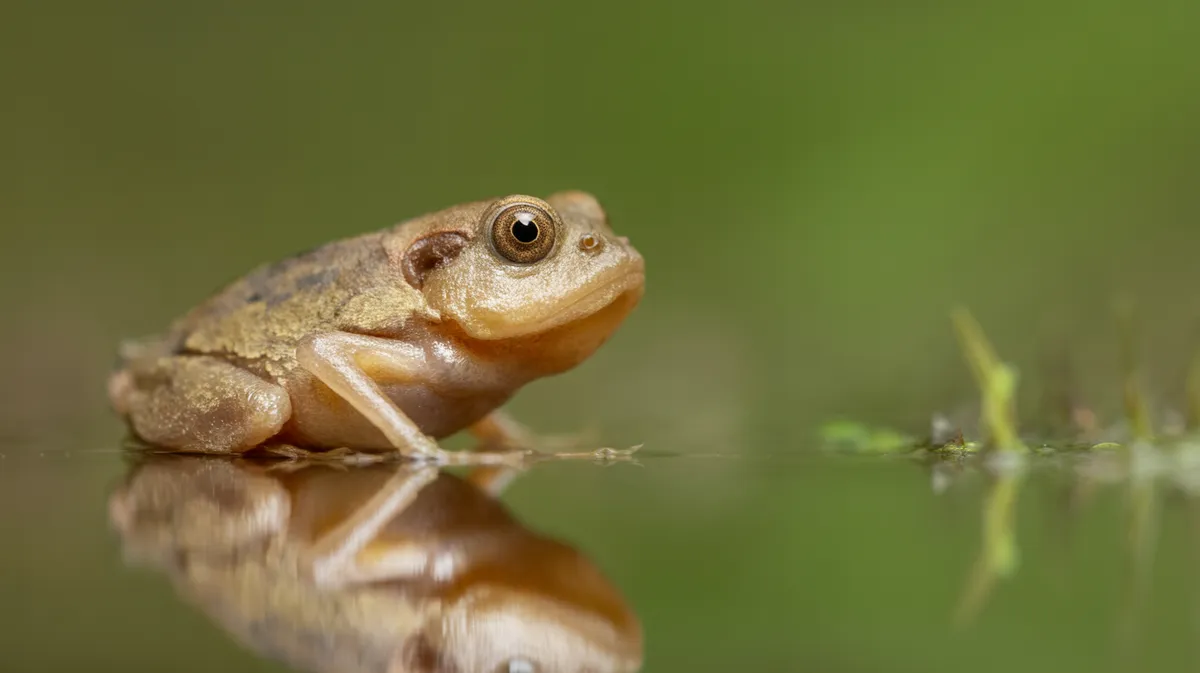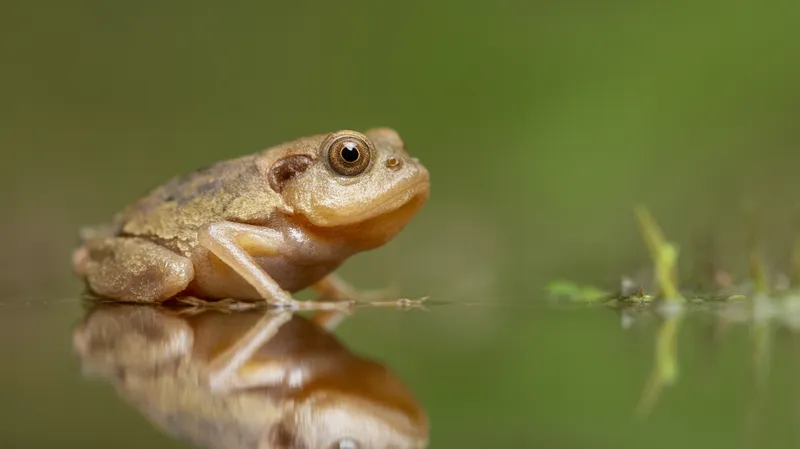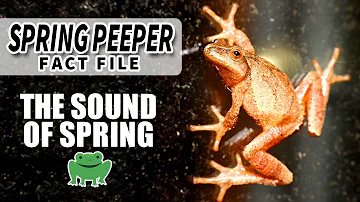
Spring Peeper
Pseudacris crucifer

Meet the Spring Peeper
The Spring Peeper is a small chorus frog native to eastern North America, famous for its loud, high-pitched calls that signal the arrival of spring. Measuring less than 4 cm in length, this tiny amphibian is well-camouflaged with brown, tan, or olive coloration and a distinctive dark X-shaped mark on its back. Spring Peepers are nocturnal and thrive in moist woodland areas, especially near vernal pools and wetlands where they breed. Despite their diminutive size, their calls can be heard from up to a mile away on warm spring nights.
Classification
Amphibian
Habitat
Forests and wooded wetlands near freshwater sources
Diet
Carnivore
Lifespan
3-4 years
Conservation
Least Concern
Weight
2-5 grams
📖Fascinating Facts
Loud Callers
Male Spring Peepers can produce calls that reach up to 90 decibels, as loud as city traffic.
Freeze Tolerance
They can survive freezing temperatures by producing glucose that acts as a natural antifreeze in their bodies.
Climbing Ability
Spring Peepers have adhesive toe pads that help them climb and cling to leaves and branches.
📋Detailed Description
The Spring Peeper (Pseudacris crucifer) is a diminutive tree frog, typically measuring 19–35 mm (0.75–1.4 in) in snout-vent length and weighing 3–5 grams. Its slender body is well-camouflaged in shades of tan, brown, gray, or olive, with a characteristic dark X-shaped dorsal marking, from which its species name 'crucifer' is derived. The skin is smooth and moist, with some subtle wart-like granularity on the back. Large, prominent toe pads aid in climbing, though the species is more terrestrial than many other hylids. The Spring Peeper’s eyes are relatively large and positioned laterally, providing a wide field of vision for detecting predators and prey. Nocturnal by nature, these frogs are most active during humid nights, especially in early spring. Their vocalizations—sharp, high-pitched 'peeps'—are produced by inflating a large vocal sac, which can be seen pulsating beneath the throat during calling. Socially, Spring Peepers are loosely gregarious during the breeding season, gathering in large choruses, but are otherwise solitary and secretive. Their diet consists primarily of small arthropods, including ants, beetles, spiders, and flies, which they capture with a rapid flick of their sticky tongue. In northern populations, Spring Peepers possess remarkable freeze tolerance, surviving partial body freezing during winter by producing high concentrations of glucose that protect their cells from ice damage.
💡 Did you know?
Despite their loud calls, Spring Peepers are rarely seen due to their small size and excellent camouflage.
🔬Research & Sources
Wikipedia Summary
The spring peeper is a small chorus frog widespread throughout the eastern United States and Canada. It prefers permanent ponds due to its advantage in avoiding predation; however, it is very adaptable with respect to the habitat it can live in. In northern regions, the frog is able to endure below freezing temperatures due to the capacity of its liver to exude and flush the bloodstream with a glucose cryoprotectant which acts both as an anti-freeze in its blood, and allows organs like the heart to enter into a state of protected dormancy. The peeper earned its name from its chirping call, which marks the beginning of spring. Crucifer is derived from the Latin root meaning "cross-bearing", a reference to the cross-like pattern on the spring peeper's dorsal side.
Last Modified: 5/23/2025
🎭Behavior & Social Structure
Spring Peepers exhibit crepuscular and nocturnal activity patterns, remaining hidden under leaf litter, logs, or loose bark during the day to avoid desiccation and predation. At night, especially during the breeding season (March to June), males emerge to call from low vegetation or the edges of shallow water bodies. The call, a single, repeated high-pitched note, serves both to attract females and to establish territory among rival males. Males may engage in aggressive interactions, including physical wrestling and call interference, to secure optimal calling sites. Outside the breeding season, Spring Peepers are solitary and cryptic, relying on their camouflage and stillness to evade predators such as snakes, birds, and small mammals. Feeding occurs opportunistically at night, with individuals using a sit-and-wait strategy to ambush small invertebrates. The species demonstrates site fidelity to breeding pools but may disperse considerable distances (up to several hundred meters) between aquatic and terrestrial habitats.
👶Reproduction & Life Cycle
Breeding occurs in early spring, often as soon as ice melts from vernal pools and wetlands. Males arrive first and establish calling territories. Females select mates based on call characteristics, with preference for louder and more frequent callers, which may indicate superior fitness. Amplexus (the mating embrace) is axillary, and females deposit 750–1,200 eggs singly or in small clusters, attaching them to submerged vegetation or detritus. The eggs hatch in 6–12 days, depending on temperature. Larval development is rapid, with tadpoles metamorphosing into froglets within 45–90 days to exploit the ephemeral nature of breeding pools. There is no parental care post-oviposition; survival of offspring is highly dependent on environmental conditions and predation pressure. Sexual maturity is typically reached within one year in southern populations and two years in northern regions.
🛡️Adaptations & Survival
Spring Peepers are renowned for their physiological freeze tolerance, a rare adaptation among amphibians. During winter, they can survive the freezing of up to 65% of their body water by accumulating glucose and urea in their tissues, which act as cryoprotectants to prevent cellular damage. Their cryptic coloration and small size provide effective camouflage against predators. Enlarged toe pads facilitate climbing on low vegetation and navigating wet, slippery substrates. The loud, high-frequency call is adapted for transmission through dense vegetation and over water, maximizing mate attraction while minimizing energy expenditure. Rapid larval development allows exploitation of temporary pools, reducing predation risk from aquatic predators. Behavioral plasticity enables the species to occupy a range of habitats, from pristine forests to suburban gardens.
📚Research Sources
🎨Cultural Significance
The Spring Peeper is an iconic harbinger of spring in eastern North America, celebrated for its distinctive chorus that signals the end of winter. Its calls are often featured in literature, folklore, and local traditions as symbols of renewal and the changing seasons. In some regions, the first peepers are used as phenological indicators for planting crops. The species has also been referenced in poetry and music, and its presence is considered a sign of healthy wetland ecosystems. There are no known traditional medicinal or culinary uses, but the Spring Peeper holds a cherished place in the natural heritage of many communities.
🔬Recent Research & Discoveries
Recent research has focused on the molecular and physiological mechanisms underlying freeze tolerance, with studies revealing the roles of specific genes and metabolic pathways in cryoprotection. Acoustic studies have examined the evolution of mating calls and the impact of environmental noise on communication. Population genetics research indicates significant gene flow among populations, but also highlights the potential for local adaptation. Ongoing monitoring programs track the effects of climate change and habitat modification on breeding phenology and distribution. The Spring Peeper is also used as a model organism for studying amphibian responses to environmental stressors and disease dynamics.
🎥Wildlife Videos

Spring Peeper Facts: the FROG that starts SPRING | Animal Fact Files
Spring peeper frogs get their common name because they're some of the first frogs to emerge in spring and they have a "peep" ...
Animal Fact Files

Six fascinating facts about Spring Peepers!
The sound of spring peepers from a pond can be almost deafening and can be heard over 2 miles away. The sound can reach 90 ...
Nature at Your Door Frank Taylor

INTO NATURE Ep.8 : Breeding season of the Spring Peeper
Music : Digya by Kevin Macleod Distributed under license Creative Commons Attribution. The Temperature of the Air by the Bow ...
Dominique Lalonde Films Nature

Spring - The Return of Life - The Secrets of Nature
A documentary about the most spectacular spring in the last fourty years. Five months of filming in the Iberian Peninsula, great ...
Go Wild

Spring Peepers! see full video for 6 surprising facts!
Nature at Your Door Frank Taylor

Peepers' Superpower They Freeze Solid & Come Back to Life! #frogs #nature #wildlife
Amazing details about the tiny Spring Peeper, the frog that serenades the Northwoods!
Northern Adventure
🌍Habitat Information
The Spring Peeper typically inhabits Forests and wooded wetlands near freshwater sources environments. Spring Peepers have adapted to their environments with specialized features and behaviors.
Primary Habitat:
Forests and wooded wetlands near freshwater sources
More detailed habitat information will be available soon.
🛡️Conservation Status
The Spring Peeper is currently classified as Least Concern. Conservation efforts are crucial for preserving this species for future generations.
Common Threats:
- 🏠Habitat loss and fragmentation
- 🌡️Climate change impacts
- 🎯Hunting and poaching
- 🏭Human-wildlife conflict
⚠️Threats & Conservation Challenges
While currently listed as Least Concern, Spring Peepers face several localized threats. Habitat loss and fragmentation due to urbanization, agriculture, and wetland drainage reduce available breeding sites. Pesticide and pollutant runoff can impair larval development and adult health. Climate change poses risks by altering the timing and duration of breeding seasons and increasing the frequency of droughts that dry out breeding pools prematurely. Disease, particularly chytridiomycosis caused by the chytrid fungus (Batrachochytrium dendrobatidis), has been detected in some populations but has not yet caused widespread declines. Road mortality during seasonal migrations is a significant threat in developed areas. Despite these challenges, the species’ adaptability and broad distribution have allowed it to maintain stable populations overall.
🔬Scientific Classification
Scientific Name
Pseudacris crucifer
Classification Hierarchy
🔍 About Taxonomic Classification
Taxonomic classification is a hierarchical system used by scientists to classify and organize living organisms based on shared characteristics and evolutionary relationships.
The system moves from broad categories (Kingdom) to increasingly specific ones, with each animal's scientific name typically consisting of its Genus and species.
📝Community Notes
Share your observations and insights about the Spring Peeper with our community of wildlife enthusiasts.
Join Our Community
Sign in to share your observations and connect with fellow wildlife enthusiasts.
Sign In to ContributeNo community notes yet
Be the first to share your observations about the Spring Peeper!
Explore Spring Peeper
Select a tab above to learn more about this amazing animal.
📸Photo Gallery
No photos available for this animal yet.
🌟Discover More Wildlife
Continue your journey of discovery with more fascinating animals from our database
